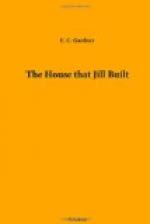[Illustration: MINED AND COUNTERMINED.]
“Brick houses, as usually built, are not much better, but that is not the fault of the bricks—they are tougher than good intentions; they have been burned once and fire agrees with them. In fact, there is no building material so thoroughly reliable, through thick and thin, in prosperity and in adversity, as good, honest, well-burned bricks. But the ordinary brick house is double—a house within a house—a wooden frame in a brick shell. Like logs in a coal-pit, the inner house is well protected from outside attacks, but the flames, once kindled within, will run about as freely as in a wooden building, and laugh at cold water, which, however abundantly it is poured out, can never reach the heart of the fire till its destructive work is accomplished. Thrown upon the outer walls, it runs down the bricks or clapboards; poured over the roof, it is carried promptly to the ground, as it ought to be; shot in through the windows, it runs down the plastering, washes off the paper, soaks the carpets, ruins the merchandise and spoils everything that water can spoil, while the fire itself roars behind the wainscot, climbs to the rafters and rages among the old papers, cobwebs and heirlooms in the attic till the roof falls in, the floors go down with a crash and an upward shower of sparks, and only the tottering walls, with their eyeless window sockets, or the ragged, blackened chimney’s, remain.”
“One road leads to fire and the other to combustion; that’s plain enough,” said Jack; “but where do the merits come in? I thought we were to learn the relative merits of bricks and wood.”
“Wood has one conspicuous merit, a virtue that covers a multitude of sins—it is cheap; but let me first arrange the fire-escapes.”




